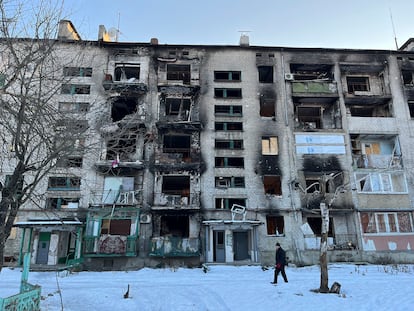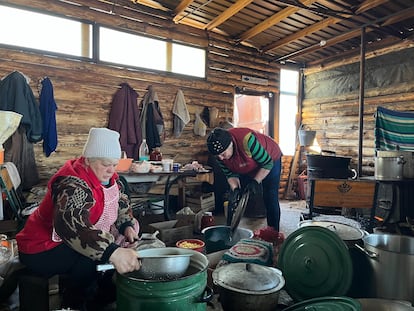Donbas, the bloodiest trench of the Ukrainian war
The Donetsk and Luhansk front line has barely moved in recent weeks with Russian and Ukrainian forces locked in static 20th-century-style battles


Oleksander Marchenko was one of those who thought that Vladimir Putin would not launch a full-scale invasion. A former factory worker in Lyman, in eastern Ukraine, Marchenko, 63, saw it as “a one in a million chance.” On the night of February 23, he had a quick bite and a cup of tea with his wife, Katya, and they went to sleep. “We were restless,” he acknowledges, shaking his head. Russia had massed tens of thousands of troops along Ukraine’s borders, and foreign intelligence services had been warning for weeks that Moscow planned to attack Ukraine. There was great skepticism inside and outside the country, but among those who thought the possibility was real, the unknown factor was on what scale the attack would come.
The atmosphere had already been electric for weeks in Donbas, which had been in a state of war for eight years between the Ukrainian army and pro-Russian separatists, backed by the Kremlin and its troops with the aim of absorbing Donetsk and Luhansk. Oleksander and Katya woke up at dawn to a call from their daughter. Putin had launched what he called a “special military operation” to “denazify” Donbas and “liberate” the Marchenkos and tens of thousands of other Russian-speaking Ukrainians. It was in fact a large-scale attack by land, sea, and air to try to take over the entire country, but it turned into a huge fiasco for Moscow, which had been counting on a quick operation but instead has suffered some 250,000 casualties – including more than 100,000 deaths, according to intelligence sources – and its exclusion from global financial markets.
A year later, with southern Ukraine partially occupied, constant bombing of civilian and energy infrastructure throughout the country, and fears of new large-scale attacks coinciding with the first anniversary of the invasion, the war seems to be fundamentally entrenched in Donbas, the region where it all began, a place where the outcome of the new Russian and Ukrainian offensives remains unknown, and where a bloody 20th-century battle is being fought in the 21st century – a battle that could decide the future of Russia’s war in Ukraine as well the European perspective.
“Everything will end and peace will come. The problem is when, and how we will be doing, and what will remain standing,” says Marchenko in the hallway of his house, which has become a storage space for firewood and water jugs. It’s almost -10ºC, the city is covered in snow and the couple, who barely go out, spend their days glued to the wood stove. The entire city, which was under Russian occupation for a few months, has been without water and gas since last May. Life has gotten even tougher in Lyman. The railway city, where some 20,000 souls lived before the invasion, is littered with potholes. A shelled building here, another one there. A huge hole in the pavement has swallowed up the bridge that leads to the train station. An attack has destroyed the shopping mall. A missile hit the concert hall.
Shelling of the town has intensified amid bloody fighting on the Kreminna-Svatove axis, where Ukraine is pushing to retake territory along a line that would place it in a position to march on Lysychansk and Severodonetsk, two large cities in Luhansk and the largest Russian conquests in the province, which it controls almost entirely. But the counter-offensive on arid terrain, littered with mined forests and destroyed villages, has not gone as expected and Moscow’s forces are striking back with force.
The Donetsk and Luhansk fronts, two of the key flanks for the new Russian offensive according to Ukrainian and Western intelligence sources, have barely moved a few meters. The war on the sometimes snow-covered often muddy eastern front has turned into a World War I-style trench battle, analysts say. And the cost in lives and equipment is enormous for both armies. Moscow, which has been besieging Bakhmut for months with relentless attacks and infantry assaults by the regular army and Wagner Group mercenaries, aims to conquer the fortress city of Donetsk in March, when the warmth of spring arrives.
Further south in industrial Avdiivka, a town already scarred by eight years of war in Donbas and with fixed trenches in place since 2014, Kremlin forces are trying to gain territory inch by inch, Major Pavlo explains. His infantry brigade has stopped to eat at a small volunteer center at the gates of Donbas where Raya and Tatiana have a huge table set and a giant cauldron of borscht, the Ukrainian beetroot soup. The situation, Pavlo acknowledges, is “difficult.”

Donbas is the priority target of Russian President Vladimir Putin. A way to justify his “special military operation.” An area next to Crimea, illegally annexed by Moscow in 2014, that those who are pressuring Ukraine to seek talks and cease fighting – usually the same voices demanding peace from Kyiv and its military backers but who ask nothing of Russia, the invading country – say that Ukraine could yield in a hypothetical negotiation. Kyiv’s goal is to regain its territorial integrity, its internationally recognized borders. And that means retaking the occupied parts of Donetsk, Luhansk, Zaporizhzhia and Crimea. Four provinces that Russia does not fully control, but which it has illegally annexed.
The Ukrainian authorities state that the new Russian offensive in the east is moving slowly. Kirilo Budanov, head of Ukraine’s military intelligence, points out that Moscow has artillery supply problems and that it is prioritizing attacks in the Bakhmut area and in the direction of Lyman, where it is increasingly using infantry assaults to preserve ammunition. Kyiv is also consuming a vast amount of shells and its Western allies are still looking for ways to increase supplies.

At Liudmila and Natacha’s house, in a hive of apartments in the south of Lyman with broken glass, cracked walls and surrounded by damaged buildings, they know nothing about ammunition. They only know that the attacks continue apace and that they are not far away. Night and day. At least 8,000 civilians (including 487 children) have been killed in Ukraine, as verified by the United Nations, which has warned that the real death toll is likely much higher, perhaps by several thousand. “The government tells us to evacuate, but where am I going to go?” says Liudmila, a 79-year-old retired nurse. She is bedridden, covered up to her neck with a yellow quilt. She can barely walk. “I would like to see the war end, but I am old. Unfortunately, I don’t think I will see the end anymore. It will continue.”
Sign up for our weekly newsletter to get more English-language news coverage from EL PAÍS USA Edition
Tu suscripción se está usando en otro dispositivo
¿Quieres añadir otro usuario a tu suscripción?
Si continúas leyendo en este dispositivo, no se podrá leer en el otro.
FlechaTu suscripción se está usando en otro dispositivo y solo puedes acceder a EL PAÍS desde un dispositivo a la vez.
Si quieres compartir tu cuenta, cambia tu suscripción a la modalidad Premium, así podrás añadir otro usuario. Cada uno accederá con su propia cuenta de email, lo que os permitirá personalizar vuestra experiencia en EL PAÍS.
¿Tienes una suscripción de empresa? Accede aquí para contratar más cuentas.
En el caso de no saber quién está usando tu cuenta, te recomendamos cambiar tu contraseña aquí.
Si decides continuar compartiendo tu cuenta, este mensaje se mostrará en tu dispositivo y en el de la otra persona que está usando tu cuenta de forma indefinida, afectando a tu experiencia de lectura. Puedes consultar aquí los términos y condiciones de la suscripción digital.
More information
Archived In
Últimas noticias
Most viewed
- Sinaloa Cartel war is taking its toll on Los Chapitos
- Oona Chaplin: ‘I told James Cameron that I was living in a treehouse and starting a permaculture project with a friend’
- Reinhard Genzel, Nobel laureate in physics: ‘One-minute videos will never give you the truth’
- Why the price of coffee has skyrocketed: from Brazilian plantations to specialty coffee houses
- Silver prices are going crazy: This is what’s fueling the rally









































